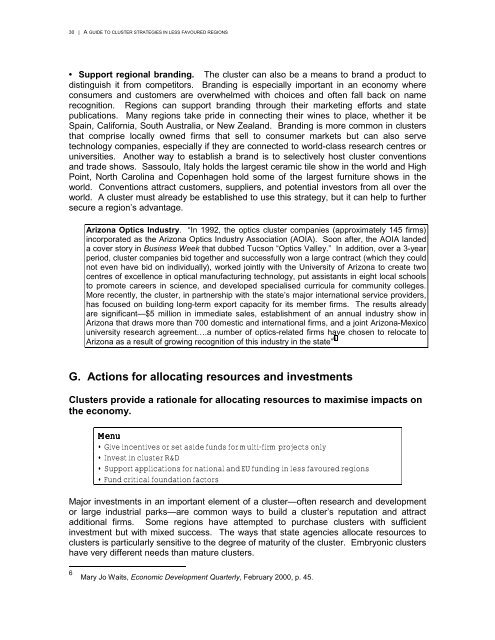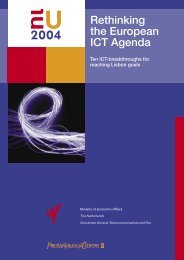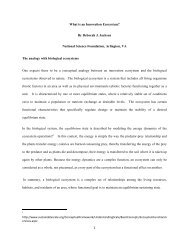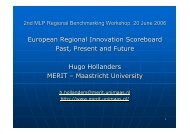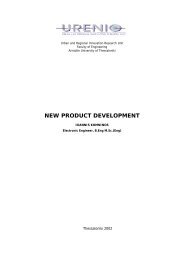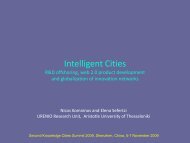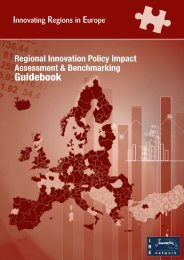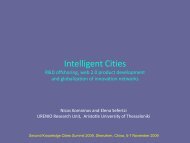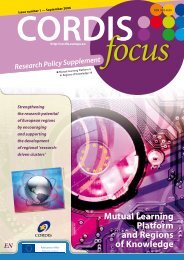Creating smart systems, guide to Cluster strategies in less favoured
Creating smart systems, guide to Cluster strategies in less favoured
Creating smart systems, guide to Cluster strategies in less favoured
Create successful ePaper yourself
Turn your PDF publications into a flip-book with our unique Google optimized e-Paper software.
30 | A GUIDE TO CLUSTER STRATEGIES IN LESS FAVOURED REGIONS<br />
• Support regional brand<strong>in</strong>g. The cluster can also be a means <strong>to</strong> brand a product <strong>to</strong><br />
dist<strong>in</strong>guish it from competi<strong>to</strong>rs. Brand<strong>in</strong>g is especially important <strong>in</strong> an economy where<br />
consumers and cus<strong>to</strong>mers are overwhelmed with choices and often fall back on name<br />
recognition. Regions can support brand<strong>in</strong>g through their market<strong>in</strong>g efforts and state<br />
publications. Many regions take pride <strong>in</strong> connect<strong>in</strong>g their w<strong>in</strong>es <strong>to</strong> place, whether it be<br />
Spa<strong>in</strong>, California, South Australia, or New Zealand. Brand<strong>in</strong>g is more common <strong>in</strong> clusters<br />
that comprise locally owned firms that sell <strong>to</strong> consumer markets but can also serve<br />
technology companies, especially if they are connected <strong>to</strong> world-class research centres or<br />
universities. Another way <strong>to</strong> establish a brand is <strong>to</strong> selectively host cluster conventions<br />
and trade shows. Sassoulo, Italy holds the largest ceramic tile show <strong>in</strong> the world and High<br />
Po<strong>in</strong>t, North Carol<strong>in</strong>a and Copenhagen hold some of the largest furniture shows <strong>in</strong> the<br />
world. Conventions attract cus<strong>to</strong>mers, suppliers, and potential <strong>in</strong>ves<strong>to</strong>rs from all over the<br />
world. A cluster must already be established <strong>to</strong> use this strategy, but it can help <strong>to</strong> further<br />
secure a region’s advantage.<br />
Arizona Optics Industry. “In 1992, the optics cluster companies (approximately 145 firms)<br />
<strong>in</strong>corporated as the Arizona Optics Industry Association (AOIA). Soon after, the AOIA landed<br />
a cover s<strong>to</strong>ry <strong>in</strong> Bus<strong>in</strong>ess Week that dubbed Tucson “Optics Valley.” In addition, over a 3-year<br />
period, cluster companies bid <strong>to</strong>gether and successfully won a large contract (which they could<br />
not even have bid on <strong>in</strong>dividually), worked jo<strong>in</strong>tly with the University of Arizona <strong>to</strong> create two<br />
centres of excellence <strong>in</strong> optical manufactur<strong>in</strong>g technology, put assistants <strong>in</strong> eight local schools<br />
<strong>to</strong> promote careers <strong>in</strong> science, and developed specialised curricula for community colleges.<br />
More recently, the cluster, <strong>in</strong> partnership with the state’s major <strong>in</strong>ternational service providers,<br />
has focused on build<strong>in</strong>g long-term export capacity for its member firms. The results already<br />
are significant—$5 million <strong>in</strong> immediate sales, establishment of an annual <strong>in</strong>dustry show <strong>in</strong><br />
Arizona that draws more than 700 domestic and <strong>in</strong>ternational firms, and a jo<strong>in</strong>t Arizona-Mexico<br />
university research agreement….a number of optics-related firms have chosen <strong>to</strong> relocate <strong>to</strong><br />
Arizona as a result of grow<strong>in</strong>g recognition of this <strong>in</strong>dustry <strong>in</strong> the state” 6<br />
G. Actions for allocat<strong>in</strong>g resources and <strong>in</strong>vestments<br />
<strong>Cluster</strong>s provide a rationale for allocat<strong>in</strong>g resources <strong>to</strong> maximise impacts on<br />
the economy.<br />
Menu<br />
• Give <strong>in</strong>centives or set aside funds for multi-firm projects only<br />
• Invest <strong>in</strong> cluster R&D<br />
• Support applications for national and EU fund<strong>in</strong>g <strong>in</strong> <strong>less</strong> <strong>favoured</strong> regions<br />
• Fund critical foundation fac<strong>to</strong>rs<br />
Major <strong>in</strong>vestments <strong>in</strong> an important element of a cluster—often research and development<br />
or large <strong>in</strong>dustrial parks—are common ways <strong>to</strong> build a cluster’s reputation and attract<br />
additional firms. Some regions have attempted <strong>to</strong> purchase clusters with sufficient<br />
<strong>in</strong>vestment but with mixed success. The ways that state agencies allocate resources <strong>to</strong><br />
clusters is particularly sensitive <strong>to</strong> the degree of maturity of the cluster. Embryonic clusters<br />
have very different needs than mature clusters.<br />
6<br />
Mary Jo Waits, Economic Development Quarterly, February 2000, p. 45.


